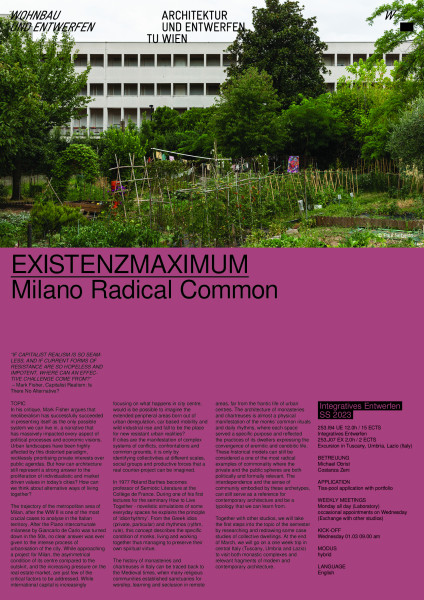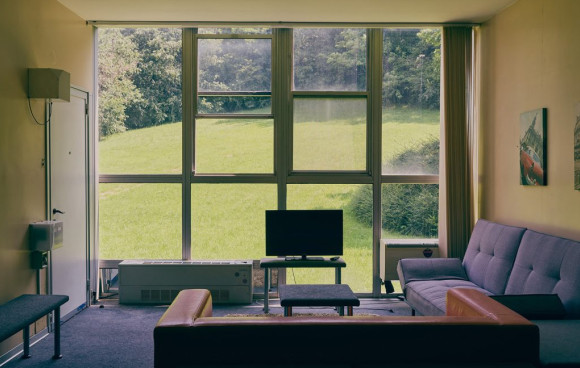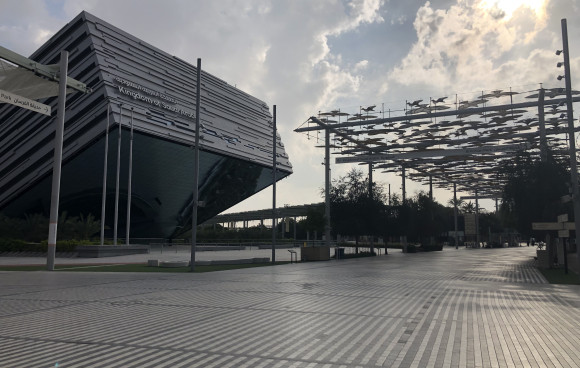Entwerfen
EXISTENZMAXIMUM Milano Radical Common
“If capitalist realism is so seamless, and if current forms of resistance are so hopeless and impotent, where can an effective challenge come from?“– Mark Fisher, Capitalist Realism: Is There No Alternative?
In his critique, Mark Fisher argues that neoliberalism has successfully succeeded in presenting itself as the only possible system we can live in, a narrative that has massively impacted every aspect of political processes and economic visions. Urban landscapes have been highly affected by this distorted paradigm, recklessly prioritising private interests over public agendas. But how can architecture still represent a strong answer to the proliferation of individualistic and market driven values in today’s cities? How can we think about alternative ways of living together?
The trajectory of the metropolitan area of Milan, after the WW II is one of the most crucial cases to analyse in the Italian territory. After the Piano intercomunale milanese by Giancarlo de Carlo was turned down in the 50s, no clear answer was ever given to the intense process of urbanisation of the city. While approaching a project for Milan, the asymmetrical condition of its centre compared to the outskirt, and the increasing pressure on the real estate market, are just few of the critical factors to be addressed. While international capital is increasingly focusing on what happens in city centre, would is be possible to imagine the extended peripheral areas born out of urban deregulation, car based mobility and wild industrial rise and fall to be the place for new resistant urban realities? If cities are the manifestation of complex systems of conflicts, confrontations and common grounds, it is only by identifying collectivities at different scales, social groups and productive forces that a real counter-project can be imagined.
In 1977 Roland Barthes becomesprofessor of Semiotic Literature at the Collège de France. During one of his first lectures for the seminary How to Live Together - novelistic simulations of some everyday spaces he explains the principle of ‘idiorrhythmy’. From the Greek idios (private, particular) and rhythmos (rythm, rule), this concept describes the specific condition of monks, living and working together thus managing to preserve their own spiritual virtue.
The history of monasteries and chartreuses in Italy can be traced back to the Medieval times, when many religious communities established sanctuaries for worship, learning and seclusion in remote areas, far from the frantic life of urban centres. The architecture of monasteries and chartreuses is almost a physical manifestation of the monks’ common rituals and daily rhythms, where each space served a specific purpose and reflected the practices of its dwellers expressing the convergence of eremitic and cenobitic life. These historical models can still be considered a one of the most radical examples of commonality where the private and the public spheres are both politically and formally relevant. The interdependence and the sense of community embodied by these archetypes, can still serve as a reference for contemporary architecture and be a typology that we can learn from.
Together with other studios, we will take the first steps into the topic of the semester by researching and redrawing some case studies of collective dwellings. At the end of March, we will go on a one week trip in central Italy (Tuscany, Umbria and Lazio) to visit both monastic complexes and relevant fragments of modern and contemporary architecture.
12h, 15 ECTS







